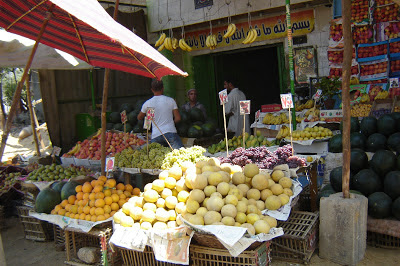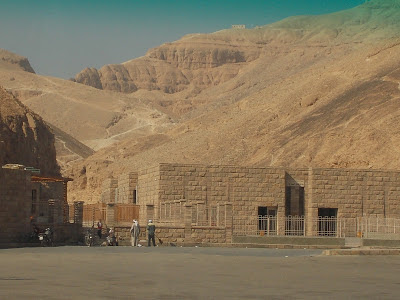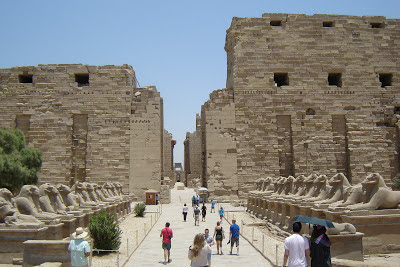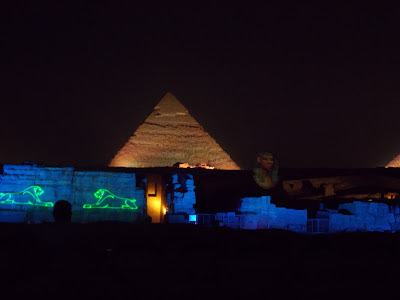I am
extremely grateful to have had the opportunity to travel to Egypt during the
small window when civil unrest was at bay. As a Peace Corps Volunteer, we are required to get approval
from a long chain of command before traveling: site supervisor, program
manager, PC medical office, PC safety & security, and the country
director. If the country of
destination is experiencing any political or health issues (e.g. Ebola), then
our request is denied. Egypt has
been on the restricted list for almost my entire service, and was finally
approved just in time for my last vacation.
While
Dorothy and I were there, our tour guide informed us of the mass protests
planned for June 30th to remove the current president from
power. (*Our trip was June
14-24.) If you read the
international headlines today, the protests and violence have already begun. While we were in Cairo, I took a
picture of the fire damage (from the 2011 revolution) to the building next to
the Egyptian Museum, which houses 120,000 ancient artifacts. It’s scary to think that the political
unrest came so close to destroying the irreplaceable remnants of history.
Aside
from protests, I have several impressions from Egypt’s culture – the first
being modern conveniences. When
coming from a village in Uganda, the first thing I notice when I travel is the
availability of electricity & running water and paved roads. But more than that, Egypt has fast
food, a shopping mall with stores I recognize (Claire’s, Toys R us, Starbuck’s, Motorola, H&M, etc.) air
conditioning, new cars, and high-rise buildings. This is not to say that there still aren’t slums, insane
taxi parks, and trash everywhere.
The good: modern convenience
The bad: poor housing and trash
Upon
arriving in Cairo, you will immediately take note of the number of smokers in
Egypt. Everyone smokes!
We saw kids as young as 14
or 15 years old smoking. And you can smoke anywhere!
Restaurants, bars, airports, hotel lobbies, even the inside the
mall! After a
few days I accepted the fact that the week was going to be filled with
second-hand smoke – my clothes still reek.
Dorothy (and the man in red) smoking inside a mall.
As a part
of every culture, food and meal times take some adjusting. The food in Egypt is classic
Mediterranean (falafel, hummus, eggplant, etc.) – I was in heaven. :) And because
we were in a tour group, a lot of the hotels had American cuisine too. One thing that Dorothy and I noticed
was the lack of fruit on the menu.
Fruit stands are everywhere in Egypt and yet we never got fruit with our
meals (or even in the buffet line?!?!) and we couldn’t figure out why.
In Uganda, leafy greens are considered
a ‘poor man’s food’ because it grows on the ground – so it is not part of daily
meals. I wondered if it was the same
way in Egypt with fruit. One of
the most difficult culture adjustments I had was with the meal times. It’s true that I usually like an early
dinner, but Egyptians take dinner from 9-11pm. Yikes!
Breakfast between 9-10am and lunch around 3-4pm. Luckily, Dorothy and I bought a bunch
of snacks to carry with us and hold us over until the next meal.
It has
been my experience that in most African countries, vendors hassle
tourists. It’s just their way of
business. “You come and buy from
me! How much!! How much do you want to pay!! I give you good price! Very nice!” Egyptian vendors seemed particularly aggressive shoving
items in your face and not taking ‘no’ for an answer. They followed us all the way to the bus, and even then stood
in window and tried waving items in front of us. One man gave Dorothy a “gift” of a scarf and put it around
her neck. She started to walk away
and he demanded that she pay for it and came after her. She threw it back at him. Also, local people offer to take your picture
in front of the pyramids or temples, then hold out their hand for payment. We learned early on not to fall for the
gimmicks.
Souvenir stand - every temple had them and they all sold the same things.


Tourism
was low because of civil unrest, but also because it was the end of June . . .
summer in Egypt. Ouch. Cairo temperatures were in the 90’s,
but traveling south to Aswan and Luxor got us 100+ degrees everyday. In the hot desert sun, we were dusty
& sweaty by 10:00am. Every
place we walked, shade was essential and we couldn’t stay in the sun for any
extended period of time. Heat
exhaustion hit me quickly and I was drinking twice as much water as I normally
do. But I still got light-headed
and fatigued until we were back in the air-conditioned bus.
Taking a break in the shade
Since
living in Uganda, I’ve become to used animals everywhere, street food vendors,
various vehicles for transportation (lorries, matatus, bodas, buses, and
bicycles), and the open markets. But here are some pictures of “Egypt Moments” that came as a
surprise, even to me.
A fresh juice stand (set up right next to traffic)
Donkeys! (We don't have them in Uganda.)
First camel sighting - a man riding a camel down the street.
It's hard to see but the silver machine is for people to get drinking water (because it's so freakin' hot there). These can be found in remote areas that don't have stores around to buy anything. Local people set up these "drinking fountains" out of the goodness of their heart. But, as a tourist, I still wouldn't drink the tap water.
Fat man on a donkey near the pyramids. Classic.





















































